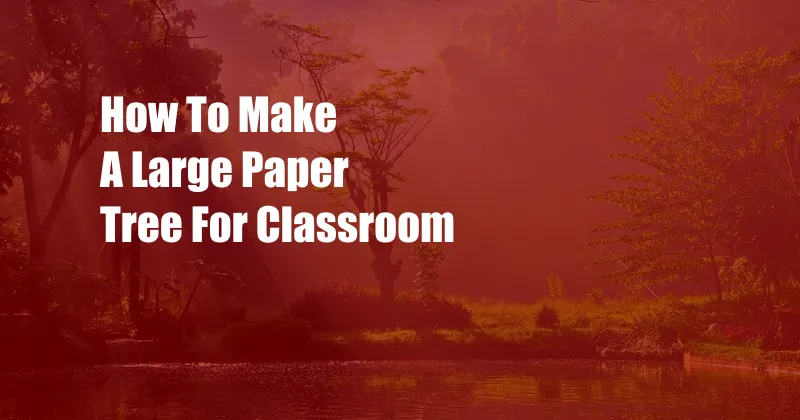
Crafting a Majestic Paper Tree for Your Classroom
In the bustling hallways of my elementary school, there stood an awe-inspiring paper tree, its verdant foliage rustling in the gentle breeze. Crafted with meticulous precision and adorned with vibrant hues, it transformed the ordinary classroom into a whimsical oasis. Its grandeur inspired me, and I longed to recreate such papery splendor in my own classroom.
The Art of Paper Sculpting: A Green Masterpiece
Paper sculpting is the delicate art of transforming two-dimensional sheets of paper into three-dimensional masterpieces. With its origins in ancient Chinese papercutting, this craft has evolved into an intricate form of expression. One of the most captivating creations in paper sculpture is the paper tree, a lush representation of nature’s beauty.
Materials Required:
- Green construction paper
- Scissors
- Glue or tape
- Optional: ribbon, markers, or paint
Step-by-Step Instructions:
-
Create the Leaves: Cut out numerous oval or teardrop-shaped leaves from green construction paper. Each leaf should be slightly different in size and curve, mimicking the diversity of nature’s foliage.
-
Shape the Leaves: Fold each leaf lengthwise and gently crease the center. Unfold and carefully curl the edges upward, giving the leaves a realistic, curled appearance.
-
Assemble the Branches: Gather several leaves and arrange them in a radial pattern, overlapping them slightly. Glue or tape them together at the base to form small branches.
-
Construct the Trunk: Roll up a piece of green construction paper to create a cylinder. Secure it with tape or glue. This will form the trunk of your paper tree.
-
Attach the Branches to the Trunk: Position the branches on the trunk and secure them with glue or tape. Start from the bottom and work your way up, staggering the branches to create a natural look.
-
Decorate (Optional): Add embellishments to your paper tree as desired. Ribbon can be tied around the branches for added color, while markers or paint can create intricate designs on the leaves.
Enhancing the Classroom Environment
A paper tree can elevate any classroom environment, fostering creativity, imagination, and a love for nature. Its vibrant hues and whimsical design serve as a constant reminder of the wonder that surrounds us.
Educational Value:
-
Nature appreciation: Paper trees bring a touch of the outdoors into the classroom, reminding students of the importance of nature and environmental stewardship.
-
Fine motor skills: Cutting, folding, and assembling the paper tree components improve students’ hand-eye coordination and fine motor skills.
-
Creativity and imagination: Paper trees encourage students to tap into their creativity and express their artistic vision. They can experiment with different leaf shapes, colors, and decorations to create unique masterpieces.
Tips and Expert Advice
-
Use sturdy paper: Opt for construction paper or cardstock for a durable and stable paper tree.
-
Layer the leaves: Overlapping leaves creates depth and realism. Experiment with different sizes and shades of green to enhance the foliage.
-
Secure the branches: Ensure the branches are firmly attached to the trunk to prevent drooping or damage.
-
Incorporate STEM concepts: Discuss the principles of geometry and symmetry while assembling the paper tree, fostering an appreciation for science and math.
-
Foster collaboration: Turn the creation of the paper tree into a group project, encouraging students to work together and share their ideas.
FAQs
Q: What type of glue is best for attaching the leaves and branches?
A: Elmer’s glue or a similar craft glue works well for paper sculpting.
Q: Can I use other colors besides green for the leaves?
A: Yes, you can experiment with different shades of green, such as lime green or emerald green, or even create a rainbow-colored tree.
Q: My paper tree is too tall for the classroom. How can I make it smaller?
A: Shorten the branches or reduce the number of branches to make the tree more compact.
Q: Can I add other elements to the paper tree?
A: Yes, you can add flowers, birds, or other decorations to create a more elaborate tree.
Conclusion
Creating a paper tree for the classroom is a rewarding and enriching experience that fosters creativity, educational value, and a love for nature. Whether you use it as a decorative centerpiece or an educational tool, this papery masterpiece will undoubtedly bring joy and inspiration to your classroom for years to come.
Are you ready to embark on the journey of crafting your own paper tree masterpiece? Let your imagination soar and embrace the art of paper sculpting!